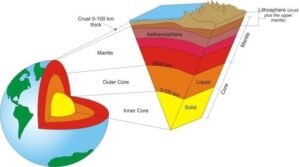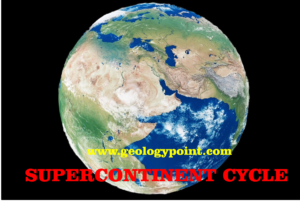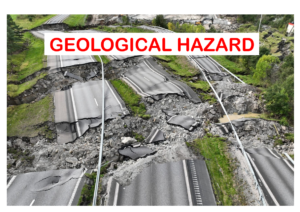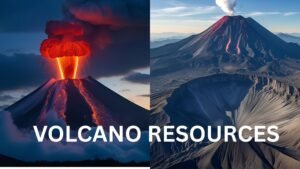The Earth beneath us may seem solid and immovable, but geologists know it hides a complex and dynamic interior. From fiery molten layers to solid metal cores, the Earth’s internal structure is a fascinating story of formation, transformation, and motion. Understanding what lies beneath the surface isn’t just an academic exercise; it helps us explain earthquakes, volcanic eruptions, mountain building, and even the Earth’s magnetic field.
Let’s journey together from the crust we walk on to the deep core we can only imagine, exploring each layer of the Earth’s interior in a way that connects science with human curiosity and wonder.
Layers of Earth
Unlike outer space, we can’t directly see inside the Earth. The deepest hole ever drilled—the Kola Superdeep Borehole in Russia—reached just about 12 kilometers, a tiny scratch on the surface compared to Earth’s 6,371 km radius. So, how do scientists know what’s beneath?
They rely on indirect evidence, especially seismic waves from earthquakes. These waves travel differently through solids, liquids, and varying densities. By analyzing how they bend, reflect, and slow down, geologists have mapped the internal structure of the Earth into three major layers: the crust, the mantle, and the core. Each is unique in composition, behavior, and role in Earth’s geology.

The Crust
The crust is the outermost layer of the Earth—the part we live on. It’s incredibly thin compared to the planet’s total size, like the skin of an apple.
Types of crust:
- Continental Crust: Thicker (30–70 km), less dense, composed mainly of granite and other felsic rocks.
- Oceanic Crust: Thinner (5–10 km), denser, made mostly of basalt and gabbro.
The crust is not a continuous shell but broken into massive tectonic plates. These plates float on the underlying mantle and slowly move, leading to earthquakes, volcanoes, and continental drift. Despite being thin, the crust is geologically active and constantly reshaped over millions of years.
The Mantle
Beneath the crust lies the mantle, which extends down to about 2,900 km. It makes up around 84% of Earth’s volume and is composed primarily of silicate rocks rich in magnesium and iron (like peridotite).
Upper vs. Lower Mantle:
- Upper Mantle (including asthenosphere): This part is partially molten and flows slowly. It’s essential for plate tectonics, allowing the rigid crustal plates to glide.
- Lower Mantle: More rigid due to immense pressure, but still capable of very slow convection currents.
These convection currents in the mantle are driven by heat from the core and radioactive decay. They act like conveyor belts, dragging tectonic plates and driving processes such as seafloor spreading and subduction.
The Core
At the center of the Earth lies the core, divided into two parts: the outer core and the inner core.
Outer Core:
- Extends from 2,900 km to 5,150 km deep.
- Composed mainly of liquid iron and nickel.
- Responsible for generating the Earth’s magnetic field through the motion of molten metal (a process called the geodynamo).
Inner Core:
- Extends from 5,150 km to the center at 6,371 km.
- Despite being hotter than the surface of the Sun (up to 5,700°C), it remains solid due to the immense pressure.
- Composed mostly of solid iron and nickel.
The core is a fascinating region. We can’t sample it directly, but seismic data and experiments under high temperature and pressure conditions help scientists estimate its composition and behavior.
The lithosphere and asthenosphere
Beyond the compositional layers (crust, mantle, core), geologists also use mechanical properties to divide Earth into:
- Lithosphere: The rigid, outer part including the crust and the uppermost mantle. It’s broken into tectonic plates.
- Asthenosphere: A softer, semi-molten layer beneath the lithosphere. It allows the plates above to move.

This structural layering is key to understanding plate tectonics, the engine behind earthquakes, mountain building, and ocean formation.
Why understanding Earth’s interior matters?
We might never visit the mantle or core, but knowing about them helps solve real-world problems.
- Earthquakes: Seismic waves help locate fault zones and understand where stress is building up.
- Volcanic Eruptions: Magma originates in the upper mantle. Understanding mantle plumes can aid in predicting eruptions.
- Natural Resources: Many valuable minerals and energy sources are formed by geological processes tied to Earth’s internal heat.
- Magnetic Field: The outer core’s motion shields us from harmful solar radiation, preserving our atmosphere and enabling life.
- Plate Tectonics: The movement of lithospheric plates explains the distribution of continents, mountain ranges, and ocean basins.
In essence, studying Earth’s interior is like learning the anatomy of a living organism. It helps us diagnose problems, make predictions, and appreciate the complexity of the world we inhabit.
Deep Earth exploration
What’s truly remarkable is the human effort behind our understanding of the Earth’s interior. From the early speculations of Greek philosophers to modern geophysics, this knowledge has been built layer by layer, just like the Earth itself.
Think of seismologists analyzing wave patterns from earthquakes, engineers building high-pressure lab equipment to simulate core conditions, or geologists piecing together rock clues from deep mines and volcanic eruptions. It’s a global, interdisciplinary effort driven by curiosity.
Even astronauts studying other planets use what we know of Earth’s structure as a model to understand Mars or the Moon. Our own planet becomes a cosmic reference point.





